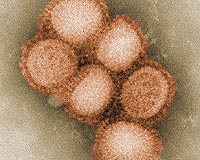| . |  |
. |
Paris (AFP) Jan 19, 2010 Already at high risk for malaria, Haiti faces an even greater likelihood that the disease will spread after the January 12 quake that killed at least 70,000, according to an assessment obtained on Tuesday by AFP. "It is highly probable that the prevalence of malaria will increase in the wake of the disaster," said Fiona Place, a researcher at British risk analysis specialists Maplecroft and co-author of the Malaria Risk Index. "Overcrowding in the camps for the displaced, inadequate shelter and sanitation, overburdened medical facilities, ruptured sewer systems -- all these factors provide favourable conditions for the breeding of malaria vectors," Place told AFP. Improvised use of open-air catchments for rainwater also make it easy for the mosquitoes that carry the disease to multiply, she said. Containing malaria's spread would partly depend on how fast aid agencies could provide long-lasting insecticidal nets, set up basic health care and distribute drugs and supplies, she added. Dysentery, measles and other mosquito-borne diseases such as dengue fever, as well as TB, influenza and other respiratory infections already lurk in Haiti and have ample means to spread among those who are weak or in poor health, living in the street or in cramped rooms, experts say. The Maplecroft Index ranks more than 100 countries most affected by malaria, based on 10 criteria including the number of cases, deaths of children under five, use of nets and distribution of drugs. Capacity to contain an outbreak is also taken into account. All but six of the 40 countries hit hardest are in Africa. Those most in peril, in the "extreme" risk category, are Democratic Republic of Congo, Angola, Yemen, Burkina Faso, Togo, Comoros and Chad. Prior to the 7.0 Richter Scale earthquake Haiti ranked 34th, which put it in the "high" category of risk. The largest non-African country at high risk is Pakistan, according to the study. "Its rating falls down most on malaria prevention, in terms of its distribution of nets, indoor residual spraying and medicinal treatment," Place said. Pakistan is also susceptible because its vast irrigation networks and monsoon rains provide ideal breeding grounds for mosquitoes. An estimated 243 million cases of malaria around the world in 2008 led to almost 863,000 deaths, according the World Health Organisation (WHO). Almost 90 percent of those deaths were in Africa, and 85 percent were children under five years of age. The remaining 10 percent of fatalities were evenly divided between Southeast Asia and the eastern Mediterranean. The use of insecticide-treated nets for sleeping and the careful use of indoor insecticides are cheap and effective ways of preventing infection, recent initiatives have shown. Africa is most vulnerable because of the combined factors of favourable conditions for the breeding of mosquitoes and inadequate resources to protect the population from the disease's spread. The high prevalence of HIV/AIDS, which depresses the immune system, increases susceptibility to malaria as well. Global warming is also set to push malaria into new regions, according to scientists. A temperature rise of only 1.0 to 2.0 degrees Celsius (1.8 to 3.6 degrees Fahrenheit) would be enough to facilitate the migration of malarial mosquitoes further north, particularly in Africa, they say.
Share This Article With Planet Earth
Related Links Epidemics on Earth - Bird Flu, HIV/AIDS, Ebola
 Greece cancels a third of flu vaccine orders
Greece cancels a third of flu vaccine ordersAthens (AFP) Jan 18, 2010 Greece cancelled Monday a third of its swine flu vaccination orders and sought compensation for the advances it paid to the big companies that provide them, the health ministry said. Meanwhile, Norway agreed a deal with British pharmaceutical giant GlaxoSmithKline (GSK) to reduce its number of vaccines by 30 percent according to its health ministry. "We will pay only for the deliveries ... read more |
|
| The content herein, unless otherwise known to be public domain, are Copyright 1995-2009 - SpaceDaily. AFP and UPI Wire Stories are copyright Agence France-Presse and United Press International. ESA Portal Reports are copyright European Space Agency. All NASA sourced material is public domain. Additional copyrights may apply in whole or part to other bona fide parties. Advertising does not imply endorsement,agreement or approval of any opinions, statements or information provided by SpaceDaily on any Web page published or hosted by SpaceDaily. Privacy Statement |